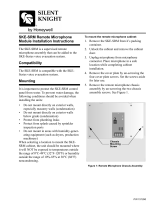Mircom FA-300-6L Series Specification
- Category
- Security access control systems
- Type
- Specification
This manual is also suitable for
Mircom FA-300-6L Series
is a cost-effective solution for smaller applications and is compatible with Mircom’s complete line of detection and notification devices as well as most other manufacturers’ equipment. Using the Mircom FA-300-6L Series provides many benefits, including reduced wiring and simplified installation, greater design flexibility, lower installed cost, and faster installation.
The FA-300-6L Series includes six (6) on-board programmable Form C relays allowing for customized control to suit any application. Features include programmable relay outputs, an on-board piezo sounder (85 dB at 10 feet), a built-in microphone, and a DTMF/analog autodialer with event and trouble reporting. Up to 15 phone numbers can be programmed with an unlimited number of phone numbers per location.
Mircom FA-300-6L Series
is a cost-effective solution for smaller applications and is compatible with Mircom’s complete line of detection and notification devices as well as most other manufacturers’ equipment. Using the Mircom FA-300-6L Series provides many benefits, including reduced wiring and simplified installation, greater design flexibility, lower installed cost, and faster installation.
The FA-300-6L Series includes six (6) on-board programmable Form C relays allowing for customized control to suit any application. Features include programmable relay outputs, an on-board piezo sounder (85 dB at 10 feet), a built-in microphone, and a DTMF/analog autodialer with event and trouble reporting. Up to 15 phone numbers can be programmed with an unlimited number of phone numbers per location.
















-
 1
1
-
 2
2
-
 3
3
-
 4
4
-
 5
5
-
 6
6
-
 7
7
-
 8
8
-
 9
9
-
 10
10
-
 11
11
-
 12
12
-
 13
13
-
 14
14
-
 15
15
-
 16
16
Mircom FA-300-6L Series Specification
- Category
- Security access control systems
- Type
- Specification
- This manual is also suitable for
Mircom FA-300-6L Series
is a cost-effective solution for smaller applications and is compatible with Mircom’s complete line of detection and notification devices as well as most other manufacturers’ equipment. Using the Mircom FA-300-6L Series provides many benefits, including reduced wiring and simplified installation, greater design flexibility, lower installed cost, and faster installation.
The FA-300-6L Series includes six (6) on-board programmable Form C relays allowing for customized control to suit any application. Features include programmable relay outputs, an on-board piezo sounder (85 dB at 10 feet), a built-in microphone, and a DTMF/analog autodialer with event and trouble reporting. Up to 15 phone numbers can be programmed with an unlimited number of phone numbers per location.
Ask a question and I''ll find the answer in the document
Finding information in a document is now easier with AI
Related papers
-
Mircom LT-453 CA-814 Operating instructions
-
Mircom SRM-312 Series Remote Smart Relay Module User manual
-
Mircom LT-658 RAM-216 Installation guide
-
Mircom LT-648 RAM-208 Installation guide
-
Mircom LT-930 MCS-6001SH Installation guide
-
Mircom LT-1095 RB-MD-950 Installation guide
-
Mircom LT-2076 Micare User guide
-
Mircom LT-472 MUFT-5000 Installation guide
-
Mircom LT-2058MIR AGD-2944-8 Installation guide
-
Mircom LT-853 BL-6B-BL-10B Installation guide
Other documents
-
 IEI Technology SRM-KIT Series User manual
IEI Technology SRM-KIT Series User manual
-
MGC IPS-4848DS Programmable Input Switches Module Owner's manual
-
MGC IPS-4848DS Programmable Input Switches Module Owner's manual
-
Secutron MR-2312-DDR Operating instructions
-
red lion RLY601 & 6A1 ‐ User manual
-
Hills 8 User manual
-
MGC IPS-2424DS Programmable Input Switches Module Owner's manual
-
MGC QBB-6001 User manual
-
 SILENT KNIGHT SKE-SRM Remote Microphone Module Installation guide
SILENT KNIGHT SKE-SRM Remote Microphone Module Installation guide
-
Transmitter XRE-100 Owner's manual

















